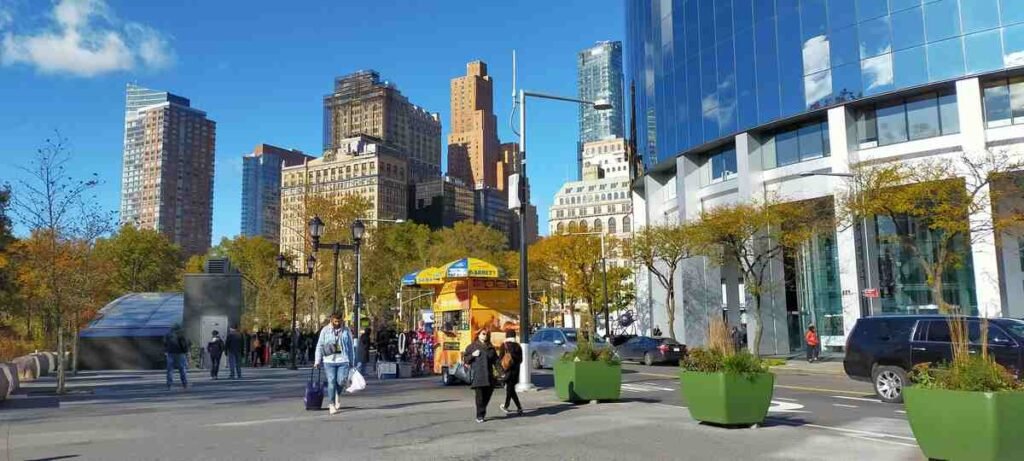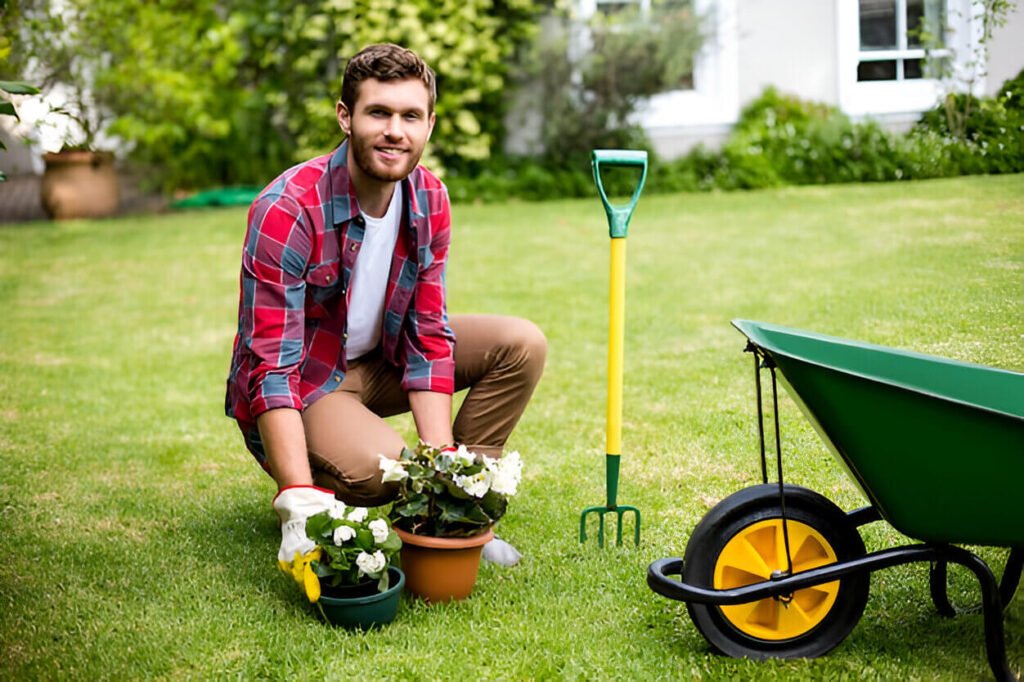Now Reading: Sustainable Urban Living: A Beginner’s Guide
-
01
Sustainable Urban Living: A Beginner’s Guide
Sustainable Urban Living: A Beginner’s Guide

What Is Urban Living? The Rise of the Modern Urban Lifestyle
Urban living refers to the experience of residing in cities and metropolitan areas where access to economic opportunities, cultural diversity, advanced infrastructure, and modern amenities shapes daily life.
The urban lifestyle is characterized by fast-paced routines, dense populations, and a reliance on public services such as transportation, healthcare, and digital connectivity. Over the past few decades, cities have become the focal points of innovation and progress, but this rapid urbanization has also led to pressing challenges such as pollution, traffic congestion, housing shortages, and excessive resource consumption.
As cities continue to expand, the need for a sustainable urban lifestyle becomes more critical than ever. The key lies in embracing eco-friendly practices, optimizing resources, and fostering inclusive communities to create healthier, more resilient cities for future generations.
Why Sustainable Urban Living Matters: Addressing Environmental and Social Challenges
Sustainable urban living is a modern approach to reducing the ecological footprint of city life while maintaining high standards of comfort and convenience.
It involves integrating green infrastructure, renewable energy, water conservation practices, and eco-friendly transportation options to create urban environments that support both people and the planet. The goal is to transform the urban lifestyle into one that prioritizes environmental responsibility, economic efficiency, and social well-being.
Here’s why sustainable urban living is essential:
- 🌱 Environmental Benefits:
- Reduces carbon emissions by promoting public transport, electric vehicles, and bicycle-friendly streets.
- Lowers air and water pollution by integrating green spaces, urban forests, and sustainable waste management.
- Preserves urban biodiversity through eco-friendly city planning, rooftop gardens, and community farming.
- 💰 Economic Benefits:
- Saves money for households by encouraging energy-efficient buildings, solar power, and water conservation technologies.
- Stimulates job growth in green industries such as sustainable architecture, renewable energy, and eco-friendly product development.
- Enhances property values in neighborhoods that prioritize sustainability and green infrastructure.
- 🏡 Social & Health Benefits:
- Improves overall quality of life by creating walkable cities, safe public spaces, and noise-free environments.
- Supports better mental and physical health through cleaner air, reduced traffic stress, and access to parks.
- Strengthens community engagement by fostering local initiatives such as urban gardening, recycling programs, and sustainable housing projects.
The Future of Urban Living: Shaping a Greener Tomorrow
As cities continue to grow, adopting a sustainable urban lifestyle is no longer a choice but a necessity. Whether you are wondering what is urban living and how to make it more sustainable or looking for practical ways to reduce your environmental footprint in the city, this guide will provide valuable insights.
In the upcoming sections, we will explore key aspects of sustainable urban living, including:
✔ Green infrastructure and eco-friendly housing
✔ Smart energy solutions and renewable resources
✔ Sustainable mobility and urban transportation
✔ Water conservation and waste reduction techniques
✔ The role of technology in transforming urban life
👉 Join us in reimagining what urban living can be—a balance between modern comfort and environmental responsibility!
The Core Principles of Sustainable Urban Living: Building a Greener and Smarter Future
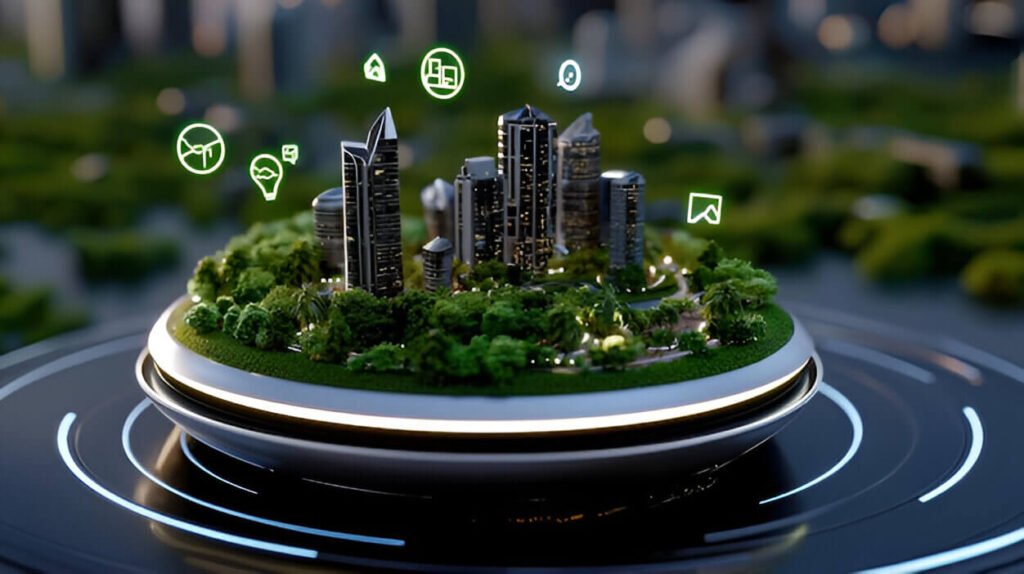
As cities continue to grow and evolve, the concept of urban living is being redefined. The traditional urban lifestyle, while offering convenience and economic opportunities, has also led to challenges such as traffic congestion, resource depletion, pollution, and social inequality.
But what is urban living if not an opportunity to innovate and create smarter, more sustainable cities? Sustainable urban living is an approach that integrates environmental responsibility, social inclusivity, and technological innovation to develop cities that are both livable and eco-friendly.
To achieve this transformation, we must focus on core principles that drive sustainability in urban environments. These principles lay the foundation for a greener and healthier urban lifestyle, ensuring that cities remain resilient, resource-efficient, and adaptable to future challenges.
1. Smart and Sustainable Urban Planning
Strategic city planning is essential for creating sustainable urban environments. Modern urban living demands cities that are well-organized, efficient, and designed to meet the needs of their residents while minimizing environmental impact.
- Mixed-Use Development: Cities must adopt mixed-use zoning, where residential, commercial, and recreational spaces are integrated to reduce commuting times, encourage walkability, and lower carbon emissions.
- Compact and Walkable Cities: Sustainable cities prioritize pedestrian-friendly infrastructure, public parks, and efficient land use to reduce urban sprawl.
- Smart City Technology: The use of AI-driven traffic management, IoT-based energy grids, and real-time data monitoring improves resource efficiency and enhances quality of life.
2. Green Infrastructure and Eco-Friendly Architecture
Green infrastructure plays a crucial role in making urban living more sustainable. What is urban living if not an opportunity to integrate nature into the built environment? Sustainable urban development prioritizes:
- Green Buildings: Eco-friendly architecture incorporates solar panels, natural ventilation, and energy-efficient materials to reduce the environmental footprint of buildings.
- Rooftop Gardens & Vertical Forests: These initiatives improve air quality, reduce urban heat, and enhance biodiversity in high-density cities.
- Urban Green Spaces: Parks, tree-lined streets, and community gardens provide environmental and psychological benefits, reducing stress and promoting social interaction.
3. Sustainable Transportation and Mobility
A sustainable urban lifestyle prioritizes eco-friendly mobility solutions to reduce dependence on fossil fuels and minimize pollution. Key aspects of sustainable transportation include:
- Public Transport Efficiency: Expanding metro systems, electric buses, and high-speed rail networks reduces individual car usage and traffic congestion.
- Cycling and Pedestrian-Friendly Cities: Investing in bike lanes, car-free zones, and pedestrian pathways makes cities more accessible and less polluted.
- Electric and Shared Mobility: The adoption of electric vehicles (EVs), car-sharing programs, and ride-hailing services contributes to a greener transport system.
4. Renewable Energy and Resource Efficiency
A sustainable urban lifestyle depends on renewable energy adoption and efficient resource utilization. To make urban living less dependent on fossil fuels, cities are transitioning towards:
- Solar, Wind, and Hydropower: Cities are investing in solar panels on rooftops, wind farms, and hydroelectric plants to generate clean energy.
- Smart Energy Grids: AI-driven grids optimize power distribution, reducing wastage and enhancing efficiency.
- Energy-Efficient Buildings: New construction and retrofitting projects integrate LED lighting, passive cooling techniques, and high-performance insulation.
5. Water Conservation and Sustainable Waste Management
What is urban living without access to clean water and effective waste disposal? Water scarcity and waste pollution are major concerns for growing cities, making sustainability in these areas a priority:
- Rainwater Harvesting & Greywater Recycling: These techniques reduce dependency on municipal water supplies and promote efficient water use.
- Zero Waste Cities: The circular economy encourages waste segregation, composting, and upcycling to minimize landfill accumulation.
- Plastic-Free Initiatives: Urban policies banning single-use plastics promote a cleaner, healthier city environment.
6. Community Engagement and Social Sustainability
A truly sustainable urban lifestyle isn’t just about the environment—it also requires strong social structures that foster inclusivity and collective responsibility. This means:
- Affordable Housing & Urban Equity: Sustainable cities must ensure that all residents, regardless of income, have access to safe and eco-friendly housing.
- Community-Led Initiatives: Urban dwellers actively participate in sustainability programs such as neighborhood clean-ups, food-sharing initiatives, and renewable energy cooperatives.
- Education and Awareness: Schools, universities, and media platforms play a key role in promoting sustainable values and empowering citizens to make informed choices.
7. The Role of Technology in Sustainable Urban Living
Technology is revolutionizing what urban living looks like in the 21st century. By integrating smart solutions and data-driven strategies, cities can optimize resources and improve quality of life. Key innovations include:
- IoT-Based Smart Cities: Smart meters, AI-driven traffic lights, and waste sensors help cities monitor energy, water, and waste management efficiently.
- Blockchain for Sustainability: Blockchain technology ensures transparency in green energy transactions and carbon credit tracking.
- AI-Powered Urban Design: Predictive analytics help city planners design spaces that are energy-efficient, resilient, and adaptable.
👉 Join us in reimagining urban living and visit EcoUrbanBloom—because the future of our cities depends on the choices we make today!
How to Make Your Urban Lifestyle More Sustainable: Practical Steps for Eco-Friendly Urban Living
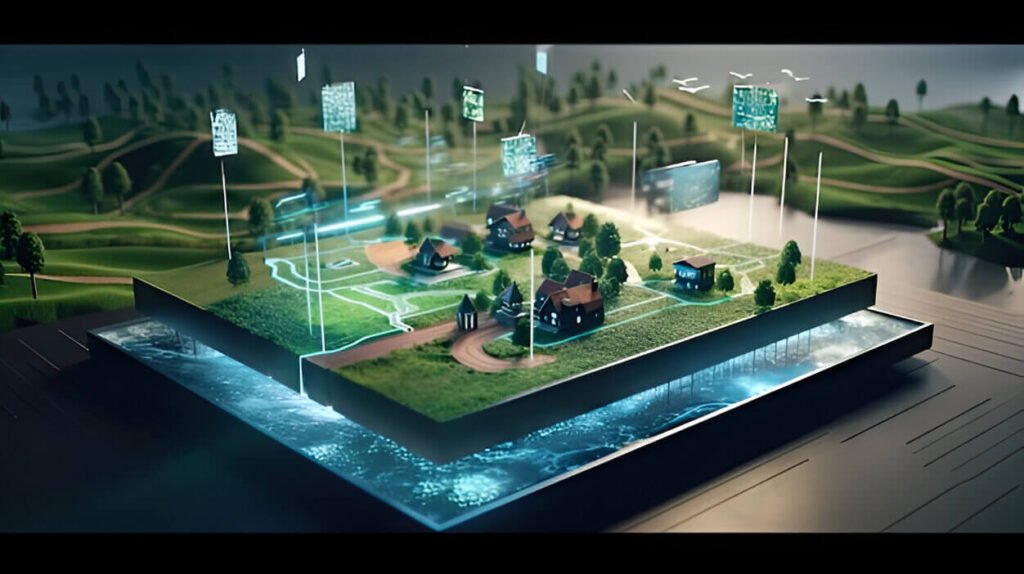
The rapid expansion of cities and the increasing global population have transformed urban living into a dynamic yet resource-intensive experience. Many people wonder, “What is urban living?” Simply put, it refers to life in densely populated areas where convenience, connectivity, and economic opportunities thrive. However, this modern urban lifestyle often comes with challenges such as pollution, excessive energy consumption, and unsustainable consumption patterns.
To mitigate these issues and create a greener, more resilient future, individuals must embrace sustainable habits in their daily lives. Whether you live in a high-rise apartment, a suburban townhouse, or a bustling city center, there are practical and effective ways to make your urban lifestyle more sustainable. Below, we explore key strategies for leading an eco-conscious life while enjoying the benefits of urban living.
1. Adopt Sustainable Transportation Choices
Transportation is a major contributor to urban pollution and carbon emissions. As cities expand, the need for efficient, clean, and sustainable mobility options becomes even more critical. Here’s how you can reduce your environmental footprint while commuting:
- Use Public Transport: Opt for buses, subways, and trains instead of personal vehicles to lower fuel consumption and traffic congestion.
- Embrace Cycling & Walking: In many urban centers, bike lanes and pedestrian pathways make cycling and walking not only sustainable but also healthier alternatives.
- Switch to Electric or Hybrid Vehicles: If driving is unavoidable, consider electric vehicles (EVs), which significantly reduce carbon emissions.
- Carpooling & Ridesharing: Sharing rides with coworkers or using ride-hailing services like Uber Pool helps decrease the number of cars on the road.
By integrating these habits into your daily routine, you contribute to a cleaner, more breathable urban environment while reducing your reliance on fossil fuels.
2. Reduce Energy Consumption in Your Home
Modern urban living is heavily dependent on energy, from powering appliances to heating and cooling systems. To reduce your urban lifestyle’s energy footprint, consider these sustainable measures:
- Switch to LED Lighting: LED bulbs consume up to 80% less energy than traditional incandescent bulbs.
- Invest in Smart Thermostats: These devices optimize temperature settings, reducing unnecessary energy consumption.
- Unplug Devices When Not in Use: Even in standby mode, electronics drain power—unplugging them can cut down energy waste.
- Use Renewable Energy Sources: If feasible, install solar panels or switch to a renewable energy provider to power your home.
By making small adjustments to your daily routine, you can lower electricity bills while making a positive impact on the environment.
3. Minimize Waste and Embrace a Zero-Waste Lifestyle
Waste management is a pressing issue in urban living, with cities generating millions of tons of waste each year. To minimize waste and promote a circular economy, follow these practices:
- Reduce Single-Use Plastics: Carry reusable shopping bags, water bottles, and coffee cups to cut down plastic waste.
- Compost Organic Waste: Food scraps and biodegradable materials can be composted instead of being sent to landfills.
- Recycle Properly: Learn about your city’s recycling system and separate materials accordingly.
- Buy Second-Hand & Upcycled Products: Supporting thrift stores and upcycled goods reduces demand for new resources.
A zero-waste urban lifestyle not only decreases environmental impact but also fosters mindful consumption.
4. Make Sustainable Food Choices
Our diet has a profound impact on the environment. The food industry contributes to carbon emissions, deforestation, and excessive water usage. To adopt a more sustainable approach to eating in an urban lifestyle, consider:
- Eating More Plant-Based Meals: Reducing meat and dairy intake can significantly lower your carbon footprint.
- Supporting Local Farmers’ Markets: Buying seasonal, locally sourced produce reduces transportation emissions and supports small businesses.
- Reducing Food Waste: Plan meals, store leftovers properly, and compost scraps to minimize waste.
- Growing Your Own Herbs & Vegetables: Urban gardening, even in small spaces, can help reduce dependence on commercial farming.
By making these choices, you contribute to a more sustainable urban food system while enjoying healthier, more nutritious meals.
5. Conserve Water in Daily Activities
Water scarcity is a growing concern in many cities. While urban living offers easy access to water, excessive consumption and wastage remain issues. You can adopt water-saving habits by:
- Turning Off Taps While Brushing or Washing Dishes: Simple actions can save gallons of water per day.
- Installing Low-Flow Fixtures: Water-efficient showerheads and faucets reduce water use without sacrificing performance.
- Fixing Leaks Promptly: A dripping faucet can waste hundreds of liters of water annually.
- Reusing Greywater: Water from washing machines and sinks can be repurposed for watering plants.
A sustainable urban lifestyle includes responsible water consumption to protect this precious resource for future generations.
6. Support Eco-Friendly Brands and Businesses
What is urban living without consumerism? Unfortunately, mass production and overconsumption contribute to pollution and waste. To shop more sustainably, you can:
- Choose Ethical & Eco-Friendly Brands: Support companies that use sustainable materials and fair labor practices.
- Invest in Quality Over Quantity: Buy durable, high-quality products that last longer instead of cheap, disposable items.
- Reduce Fast Fashion Consumption: Opt for sustainable clothing brands or thrift stores to minimize textile waste.
Your purchasing decisions can drive positive change in industries by encouraging sustainable business practices.
7. Engage in Community-Led Sustainability Initiatives
One of the most rewarding aspects of urban living is the sense of community. Sustainable change is more effective when done collectively. Get involved by:
- Participating in Local Clean-Ups: Join groups that organize beach or park clean-ups.
- Advocating for Green Policies: Support city initiatives for better waste management, green spaces, and pollution control.
- Starting Sustainability Projects: Whether it’s a community garden or a recycling drive, grassroots efforts make a difference.
- Educating Others: Share knowledge about sustainability through blogs, social media, or workshops.
Building a sustainable urban lifestyle isn’t just about individual actions—it’s about collective responsibility.
8. Incorporate Smart Technology for a Greener Home
Modern urban living benefits from technological advancements that promote sustainability. To create an eco-friendly home:
- Use Smart Home Devices: Smart plugs, energy-efficient appliances, and automated lighting reduce energy waste.
- Install Solar Panels: If possible, invest in solar energy to decrease reliance on fossil fuels.
- Monitor Energy Usage: Apps and smart meters can help track and optimize household energy consumption.
Integrating technology into your urban lifestyle ensures that sustainability remains both practical and efficient. Explore more ways to live sustainably at EcoUrbanBloom.
👉 Start today—because the future of urban living is in our hands!
The Benefits of Sustainable Urban Living: Why an Eco-Friendly Urban Lifestyle Matters
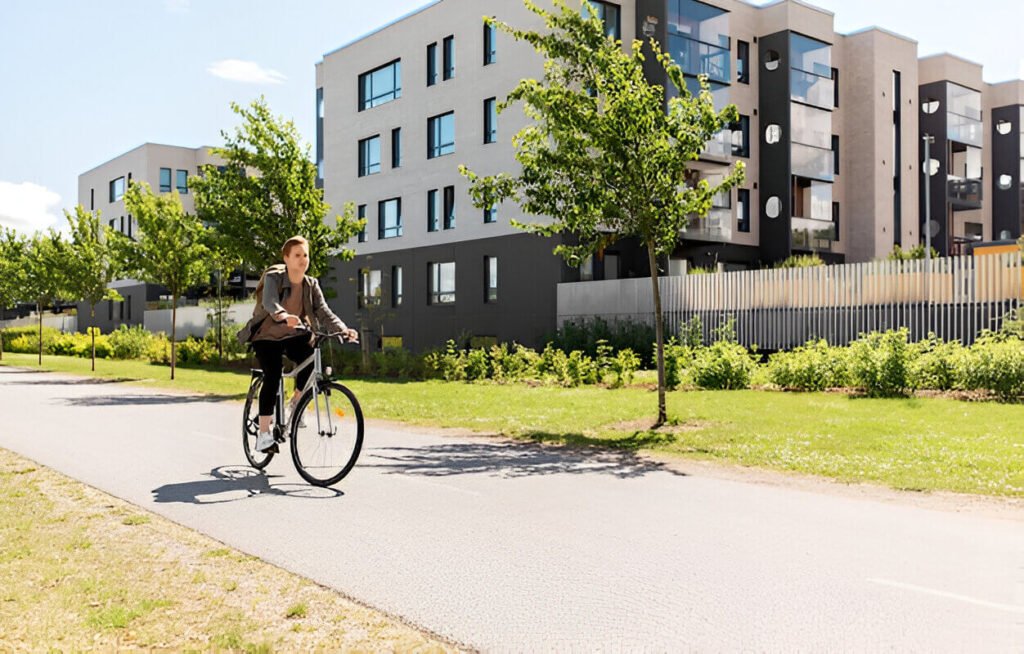
In today’s fast-paced world, urban living has become the dominant way of life, offering convenience, economic opportunities, and cultural diversity. But as cities grow, so do the challenges—pollution, waste, congestion, and resource depletion. This is where sustainable urban living comes in, providing a way to enjoy the perks of city life while minimizing environmental harm.
Many people ask, “What is urban living?” In simple terms, it is the experience of residing in a city or metropolitan area, where access to amenities, jobs, and social interactions is abundant. However, not all urban lifestyles are sustainable. An eco-conscious urban lifestyle focuses on reducing the ecological footprint while maintaining or even enhancing the quality of life.
By adopting sustainable practices, individuals and communities can reap significant benefits—not just for the environment but also for public health, the economy, and overall well-being. Let’s explore the key advantages of sustainable urban living and why making eco-friendly choices is a smart decision for both present and future generations.
1. Improved Air Quality and a Healthier Living Environment
One of the biggest drawbacks of urban living is air pollution caused by vehicle emissions, industrial activities, and waste incineration. A sustainable urban lifestyle helps combat this issue by:
- Promoting Green Spaces: Trees and parks absorb pollutants, providing cleaner air.
- Encouraging Public Transport & Cycling: Fewer private vehicles on the road reduce smog and carbon emissions.
- Using Renewable Energy Sources: Switching to solar and wind energy decreases the burning of fossil fuels.
When cities embrace sustainability, air quality improves, leading to fewer respiratory diseases, allergies, and cardiovascular problems among residents.
2. Reduced Carbon Footprint and Climate Resilience
Cities are responsible for over 70% of global carbon emissions, making urban living a major contributor to climate change. A shift toward sustainable practices results in:
- Lower Greenhouse Gas Emissions: Energy-efficient buildings, electric transportation, and smart grids reduce overall emissions.
- Better Waste Management: Recycling, composting, and a zero-waste mindset prevent methane emissions from landfills.
- Climate Adaptation Measures: Green roofs, rainwater harvesting, and sustainable infrastructure help cities withstand extreme weather conditions.
By adopting a sustainable urban lifestyle, individuals help mitigate climate change while creating more resilient communities.
3. Cost Savings for Individuals and Households
Contrary to popular belief, sustainable urban living isn’t just good for the environment—it’s also great for your wallet! Eco-friendly choices often lead to significant financial savings, such as:
- Lower Energy Bills: Using LED lighting, smart thermostats, and energy-efficient appliances reduces electricity consumption.
- Reduced Transportation Costs: Walking, cycling, and public transit are much cheaper than owning a car.
- Minimized Waste & Smarter Consumption: Buying second-hand goods, repairing instead of replacing, and reducing food waste all lead to savings.
A sustainable urban lifestyle encourages conscious spending, ultimately improving financial well-being.
4. Enhanced Physical and Mental Well-Being
Sustainable urban living promotes habits that contribute to better health and overall happiness. These include:
- Active Lifestyles: Walking and cycling instead of driving improves cardiovascular fitness.
- Access to Green Spaces: Studies show that spending time in nature reduces stress, anxiety, and depression.
- Healthier Diets: Choosing locally sourced, organic, and plant-based foods reduces exposure to harmful chemicals while supporting local farmers.
A balanced urban lifestyle that prioritizes sustainability leads to a higher quality of life, increased longevity, and greater emotional well-being.
5. Stronger Local Economies and Job Creation
Sustainability isn’t just about the environment—it also has profound economic benefits. As cities transition toward eco-friendly urban living, they generate new economic opportunities, such as:
- Green Job Creation: Renewable energy, sustainable construction, and recycling industries create employment opportunities.
- Support for Local Businesses: Farmers’ markets, ethical brands, and circular economies thrive in sustainable cities.
- Increased Property Values: Eco-friendly buildings and walkable neighborhoods attract buyers and investors.
A sustainable urban lifestyle stimulates local economies while ensuring long-term prosperity for communities.
6. More Efficient Use of Resources
Sustainable urban living revolves around optimizing resources to reduce waste and improve efficiency. Key aspects include:
- Water Conservation: Low-flow fixtures, rainwater harvesting, and smart irrigation systems reduce water wastage.
- Energy Efficiency: Smart homes, green architecture, and solar energy reduce dependency on non-renewable power sources.
- Waste Reduction: Circular economies focus on reusing, repurposing, and recycling materials instead of discarding them.
Efficient resource use ensures that future generations can enjoy the benefits of urban living without depleting natural reserves.
7. Strengthened Community Engagement and Social Cohesion
Sustainable cities foster a sense of community and social responsibility, where people actively participate in environmental initiatives. This can lead to:
- Increased Civic Engagement: Residents are more likely to support green policies, local businesses, and community-driven projects.
- More Inclusive Public Spaces: Parks, pedestrian-friendly streets, and cultural hubs create vibrant social interactions.
- Shared Sustainability Efforts: Community gardens, carpool programs, and local clean-up events bring people together.
A sustainable urban lifestyle cultivates a strong sense of belonging and shared responsibility among residents.
8. Greater Resilience Against Urban Challenges
Sustainable cities are better equipped to handle challenges such as population growth, infrastructure strain, and economic instability. Key resilience factors include:
- Disaster Preparedness: Green infrastructure, flood management, and renewable energy sources ensure cities can adapt to climate-related disasters.
- Sustainable Urban Planning: Mixed-use developments reduce travel time, improving convenience and resource efficiency.
- Diversified Economies: Green industries create long-term stability and reduce dependence on limited resources.
By embracing sustainable urban living, cities become stronger, safer, and more adaptable to future challenges.
👉 The time to embrace sustainable urban living is now—because the future of our cities depends on the actions we take today! Discover more about sustainable urban living at EcoUrbanBloom.
The Future of Sustainable Cities: Innovations and Challenges Shaping Urban Living

As global populations continue to shift towards cities, the concept of urban living is undergoing a dramatic transformation. More than half of the world’s population resides in urban areas, and by 2050, this number is expected to reach nearly 70%. With this rapid urbanization comes an urgent need to develop cities that are not only livable but also sustainable.
What is urban living? At its core, it refers to the experience of residing in metropolitan areas where people engage in work, education, social activities, and cultural interactions. However, the traditional urban lifestyle has often prioritized economic growth over environmental responsibility, leading to challenges such as pollution, resource depletion, and inadequate infrastructure.
Looking ahead, the future of sustainable cities hinges on innovative solutions that balance urban expansion with ecological preservation. Emerging technologies, policy shifts, and community-driven initiatives are paving the way for greener, smarter, and more resilient cities.
1. Smart Cities: The Integration of Technology in Urban Living
One of the most significant trends shaping the future of urban lifestyle is the rise of smart cities—urban environments that leverage technology to optimize resources, improve efficiency, and enhance residents’ quality of life. Key developments include:
- IoT and AI in Urban Planning: Artificial Intelligence (AI) and the Internet of Things (IoT) are being used to monitor traffic flow, manage waste collection, and enhance energy efficiency.
- Smart Grids and Renewable Energy: Future cities will increasingly rely on decentralized energy sources such as solar, wind, and hydropower, coupled with smart grids that distribute electricity based on real-time demand.
- 5G Connectivity and Digital Infrastructure: Faster internet and enhanced connectivity will facilitate remote work, digital governance, and improved public services.
By embracing digital transformation, urban living will become more convenient, efficient, and environmentally sustainable.
2. Sustainable Architecture and Green Infrastructure
The buildings and infrastructure of the future must be designed to minimize environmental impact while maximizing functionality. Sustainable architectural trends include:
- Net-Zero and Carbon-Neutral Buildings: Future constructions will prioritize energy-efficient designs, using renewable materials and smart technology to reduce carbon footprints.
- Green Roofs and Vertical Gardens: Integrating nature into high-rise buildings helps regulate temperature, improve air quality, and promote biodiversity.
- Sustainable Public Spaces: Parks, pedestrian-friendly zones, and eco-friendly transportation hubs will become essential features of modern urban lifestyle.
These advancements will redefine what is urban living, making cities more aesthetically pleasing, functional, and environmentally responsible.
3. Circular Economies and Waste Management Innovations
A sustainable future requires a shift from the traditional “take-make-dispose” economic model to a circular economy, where waste is minimized, reused, and repurposed. Key innovations include:
- Zero-Waste Cities: Cities like San Francisco and Stockholm are implementing aggressive waste reduction policies that focus on composting, recycling, and banning single-use plastics.
- Waste-to-Energy Technologies: Converting organic waste into biofuels or electricity will help reduce landfill usage and provide alternative energy sources.
- Product Lifecycle Extensions: The rise of repair, reuse, and upcycling industries will encourage people to keep products in circulation for longer.
As these systems become mainstream, urban living will become less wasteful and more resource-efficient.
4. Sustainable Transportation and the Shift Toward Car-Free Cities
The future of urban lifestyle will be shaped by sustainable mobility solutions that reduce congestion and carbon emissions. Some of the biggest shifts in urban transportation include:
- Expansion of Public Transport Networks: High-speed rail, electric buses, and metro systems will become the backbone of sustainable cities.
- Rise of Micromobility: Electric scooters, bikes, and shared mobility services will make short-distance travel more eco-friendly.
- Car-Free Urban Zones: Some cities are already experimenting with pedestrian-only areas to reduce emissions and promote healthier lifestyles.
By making transportation more sustainable, cities will improve air quality, reduce traffic stress, and encourage more active urban living.
5. Water Conservation and Climate-Resilient Urban Planning
Water scarcity and climate change pose significant threats to cities worldwide. To secure a sustainable future, urban areas must focus on:
- Smart Water Management Systems: IoT-enabled sensors can detect leaks and optimize water usage in buildings and public infrastructure.
- Desalination and Water Recycling: Advanced filtration systems will allow cities to reuse wastewater efficiently, reducing reliance on freshwater sources.
- Flood-Resilient Infrastructure: Green stormwater solutions, such as rain gardens and permeable pavements, will help mitigate flooding caused by extreme weather.
Incorporating these water conservation strategies into urban lifestyle planning will ensure that future cities remain livable and sustainable.
6. Renewable Energy and Decentralized Power Grids
A clean energy revolution is essential for the sustainability of urban living. The transition to renewable energy sources will be driven by:
- Solar and Wind Energy Expansion: Cities will increase investment in local solar farms and wind turbines to reduce dependency on fossil fuels.
- Energy-Efficient Buildings: Smart thermostats, energy storage batteries, and AI-driven energy management will reduce urban energy consumption.
- Decentralized Power Networks: Microgrids and peer-to-peer energy trading will allow residents to generate and share electricity independently.
By embracing renewable energy, cities will lower emissions and make sustainable urban living the norm.
7. Policy Innovations and Community-Led Initiatives
Governments and local communities will play a crucial role in shaping the future of sustainable cities. Key policy trends include:
- Green Building Mandates: Many governments are introducing strict energy efficiency standards for new buildings.
- Carbon Pricing and Incentives: Tax breaks and subsidies for eco-friendly businesses and individuals will encourage sustainable choices.
- Community-Led Sustainability Projects: Urban farming, shared solar programs, and grassroots clean-up efforts will empower residents to take an active role in sustainability.
These policies will accelerate the transition toward a sustainable urban lifestyle while ensuring widespread participation.
8. Social Equity and Inclusive Urban Development
A truly sustainable city must be inclusive and provide equal opportunities for all its residents. Future developments in urban living will emphasize:
- Affordable Sustainable Housing: Eco-friendly housing should be accessible to all income groups, not just the wealthy.
- Universal Green Spaces: Every neighborhood should have access to parks and recreational areas.
- Diverse and Inclusive City Planning: Future cities must be designed to cater to people of all abilities, ages, and backgrounds.
A fair and sustainable urban lifestyle ensures that no one is left behind in the pursuit of environmental and economic progress.
👉 The future is green, smart, and sustainable. The question is: Are we ready to make the change today? If you are ready discover more about sustainable urban living at EcoUrbanBloom.
Practical Steps: How to Start Your Sustainable Urban Journey Today
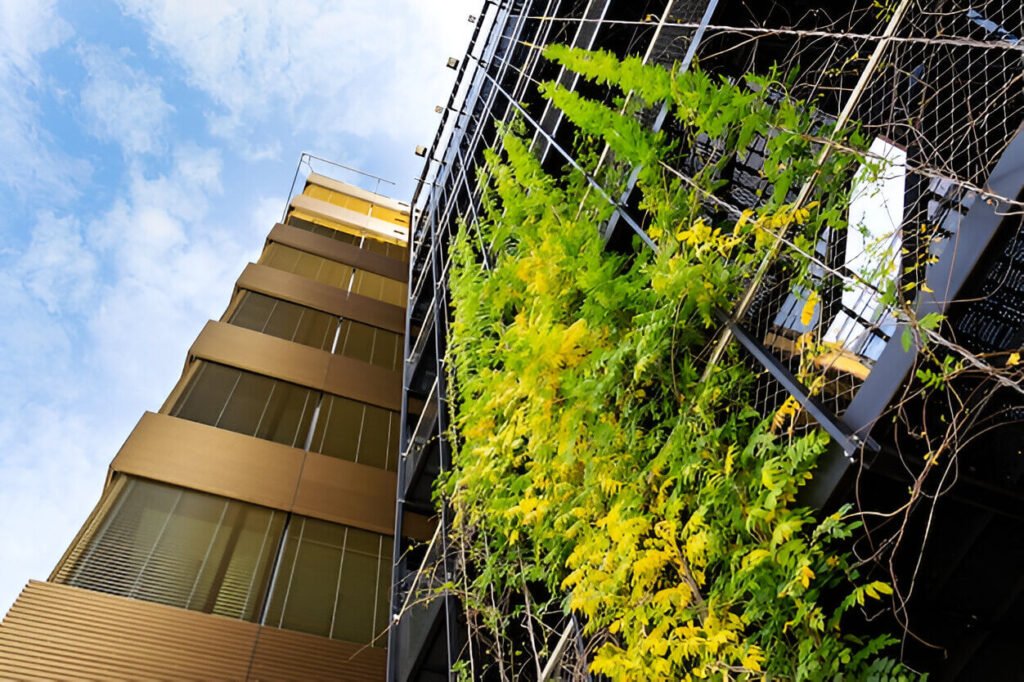
As cities continue to grow and evolve, the concept of urban living is shifting towards sustainability. Many individuals are beginning to ask: What is urban living, and how can we make it more environmentally responsible? Sustainable urban lifestyle choices are no longer limited to policymakers or large corporations—every city dweller has the power to contribute to a greener future.
If you’re ready to adopt a more eco-friendly urban lifestyle, this guide will provide practical steps to help you start your sustainable urban journey today. From simple daily habits to long-term commitments, these actionable strategies will empower you to make a meaningful impact on your city and the planet. Explore more sustainable urban living insights at EcoUrbanBloom.
1. Reduce Your Carbon Footprint in Urban Living
One of the most effective ways to live sustainably in a city is by minimizing your carbon emissions. You can achieve this by:
- Choosing Sustainable Transportation: Walk, cycle, or use public transport instead of relying on private vehicles. If driving is necessary, consider carpooling or switching to an electric vehicle.
- Optimizing Energy Consumption: Use energy-efficient appliances, switch to LED bulbs, and turn off lights and electronics when not in use.
- Supporting Renewable Energy: If your city offers renewable energy plans, opt for solar, wind, or hydro-powered electricity. Some regions even allow homeowners to install solar panels.
- Eating a Low-Carbon Diet: Reduce meat and dairy consumption, as animal agriculture significantly contributes to greenhouse gas emissions. Opt for local and organic food whenever possible.
By making these adjustments, you can significantly lower your environmental impact while enhancing the sustainability of your urban lifestyle.
2. Minimize Waste and Embrace a Circular Economy
Waste management is a major challenge in urban areas. To reduce landfill waste and promote a circular economy, consider these steps:
- Adopt the 3R Principle (Reduce, Reuse, Recycle): Be mindful of your consumption, reuse materials, and recycle properly according to your city’s waste management guidelines.
- Compost Organic Waste: If your city has a composting program, participate in it. Alternatively, consider composting at home to reduce food waste.
- Avoid Single-Use Plastics: Carry a reusable water bottle, coffee cup, and shopping bag. Choose biodegradable or recyclable packaging whenever possible.
- Shop Sustainably: Support brands that prioritize ethical and eco-friendly production practices. Opt for second-hand items when possible.
By incorporating these waste reduction habits into your urban lifestyle, you contribute to a cleaner and more sustainable city.
3. Conserve Water and Promote Sustainable Water Use
Water scarcity is a growing concern in many urban areas. To ensure responsible water consumption, follow these steps:
- Install Water-Saving Fixtures: Low-flow showerheads, faucets, and toilets can significantly reduce water use.
- Collect Rainwater: If possible, install a rainwater harvesting system for watering plants or cleaning purposes.
- Fix Leaks Immediately: A dripping faucet can waste gallons of water over time. Regularly check your plumbing to prevent unnecessary water loss.
- Practice Mindful Water Use: Turn off taps while brushing your teeth, take shorter showers, and only run dishwashers or washing machines with full loads.
Sustainable water practices are essential for maintaining urban living environments that are resilient to climate change and resource shortages.
4. Green Your Home and Living Space
Creating an eco-friendly home is a great way to promote sustainable urban living. Here are a few ways to make your living space more sustainable:
- Grow Indoor Plants or Start an Urban Garden: Houseplants improve air quality, while growing herbs or vegetables reduces reliance on store-bought produce.
- Improve Indoor Air Quality: Use air-purifying plants, minimize synthetic air fresheners, and ensure proper ventilation in your home.
- Use Sustainable Materials: Opt for eco-friendly furniture, decor, and building materials when renovating or furnishing your home.
- Upgrade to Energy-Efficient Appliances: Choose appliances with high energy ratings to reduce electricity consumption.
Sustainable homes create a healthier urban lifestyle, benefiting both residents and the environment.
5. Support Sustainable Urban Initiatives and Local Businesses
A truly sustainable urban lifestyle requires community participation. Get involved by:
- Shopping Locally: Support local farmers’ markets, businesses, and sustainable brands instead of large, high-carbon-footprint corporations.
- Participating in Urban Green Projects: Volunteer for local clean-up drives, tree-planting initiatives, or community gardening projects.
- Advocating for Green Policies: Stay informed about city policies and support initiatives that promote sustainability. Engage with local government representatives to push for eco-friendly reforms.
- Joining Sustainability Groups: Connect with like-minded individuals through sustainability organizations, social media groups, or local meetups.
A sustainable city thrives when its residents actively participate in shaping eco-friendly policies and community-driven initiatives.
6. Make Smarter Consumer Choices
Every purchase decision you make has an environmental impact. Adopt conscious consumerism by:
- Buying Quality Over Quantity: Invest in durable, high-quality products rather than cheap, disposable alternatives.
- Supporting Ethical and Sustainable Brands: Research brands that prioritize fair labor practices, eco-friendly materials, and carbon neutrality.
- Embracing a Minimalist Lifestyle: Reduce clutter, avoid impulse purchases, and focus on buying only what you truly need.
By shifting towards ethical consumption, you align your spending habits with a sustainable urban lifestyle.
7. Educate Yourself and Others on Sustainable Urban Living
Knowledge is key to fostering long-term change. Stay informed and share your insights by:
- Reading Books and Articles on Sustainability: Follow reputable sustainability blogs, news sources, and research papers to stay updated on global trends.
- Attending Sustainability Workshops and Events: Many cities offer workshops on eco-friendly practices, green technology, and sustainable living.
- Sharing Information with Family and Friends: Encourage others to adopt sustainable habits by leading by example and sharing practical tips.
Educating yourself and spreading awareness helps create a collective movement toward more responsible urban living.
8. Utilize Smart Technology for Sustainable Living
Advancements in technology have made it easier than ever to integrate sustainability into everyday urban lifestyle choices. Take advantage of:
- Smart Home Devices: Use smart thermostats, energy monitors, and automated lighting systems to optimize energy consumption.
- Eco-Friendly Apps: Download apps that track carbon footprints, locate recycling centers, or suggest sustainable shopping options.
- Electric and Hybrid Vehicles: If you need a personal vehicle, opt for an electric or hybrid car to reduce emissions.
Smart technology plays a crucial role in enhancing the efficiency and sustainability of urban living. Discover more about it at EcoUrbanBloom.🌱 The future of our cities depends on the actions we take today. Are you ready to make a difference?
Conclusion & Call to Action: Shaping a Sustainable Urban Future
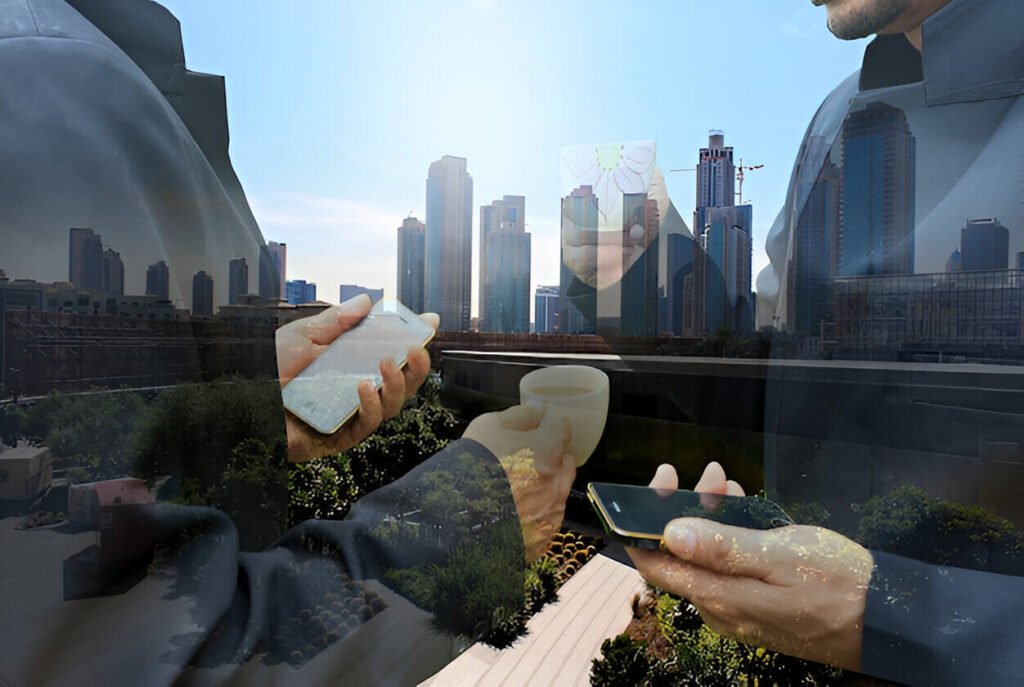
Rethinking What Urban Living Means
As we navigate the complexities of modern cities, it becomes crucial to ask ourselves: What is urban living, and how can we redefine it for a sustainable future? Traditionally, urban living has been associated with fast-paced lifestyles, high energy consumption, and increased environmental footprints. However, as cities evolve, so must our approach to them.
Sustainable urban lifestyle choices are no longer a luxury; they are a necessity. By making conscious decisions in energy use, transportation, waste management, and community engagement, we can reshape our cities into vibrant, eco-friendly, and livable spaces. The responsibility lies not only with policymakers and corporations but with each individual who calls a city home.
The Power of Individual Action in Sustainable Urban Living
One of the biggest misconceptions about sustainability is that individual actions don’t make a difference. In reality, collective small efforts create massive change. If millions of urban dwellers commit to sustainable habits, the overall impact on resource conservation, pollution reduction, and climate resilience will be substantial.
Every conscious choice—be it opting for public transportation, reducing waste, supporting green businesses, or advocating for sustainable policies—contributes to a healthier urban lifestyle for present and future generations. Urban living is about more than convenience; it’s about creating a balance between development and environmental responsibility.
Your Role in Shaping a Greener Urban Future
For transition towards a more sustainable urban lifestyle, consider the following:
- Start Small, but Start Now – You don’t need to overhaul your entire lifestyle overnight. Begin with simple habits like reducing plastic use, conserving water, or switching to energy-efficient appliances.
- Be a Conscious Consumer – Support brands, businesses, and initiatives that prioritize sustainability. Your purchasing decisions drive market demand for eco-friendly alternatives.
- Engage in Community Initiatives – Join local environmental groups, participate in clean-up campaigns, or contribute to urban greening projects.
- Stay Informed and Educate Others – Read about sustainable practices, attend workshops, and share knowledge with friends and family. Awareness is the first step toward meaningful change.
- Advocate for Policy Changes – Urban policies play a significant role in sustainability. Engage with local leaders and support policies that promote green spaces, renewable energy, and waste management reforms.
By implementing these actions, you become part of the larger movement transforming urban living into a model of sustainability and resilience.
The Future of Sustainable Urban Living
Looking ahead, the cities of tomorrow will depend on the actions we take today. Sustainable urban development is no longer a choice—it is an imperative. The transition to eco-friendly urban living will require innovation, collaboration, and a commitment to changing how we interact with our environment.
Technological advancements such as smart grids, renewable energy solutions, and AI-driven sustainability tools are already shaping the future of cities. But technology alone is not enough—human action, awareness, and responsibility are just as critical.
A truly sustainable urban lifestyle means living in harmony with the city’s ecosystem while ensuring that future generations can enjoy the same quality of life.
Call to Action: Join the Sustainable Urban Movement
You have the knowledge, the tools, and the ability to make a difference. Now, it’s time to take action.
🌿 Start Today – Choose one sustainable habit to implement in your daily routine.
🏙️ Get Involved – Engage with your community and support local sustainability initiatives.
♻️ Inspire Others – Share your journey, spread awareness, and encourage others to adopt eco-friendly practices.
Urban living is what we make it. Let’s build cities that are not just places to live, but places to thrive—greener, cleaner, and more sustainable than ever before. Visit EcoUrbanBloom for more insights and practical steps to make a lasting impact.


